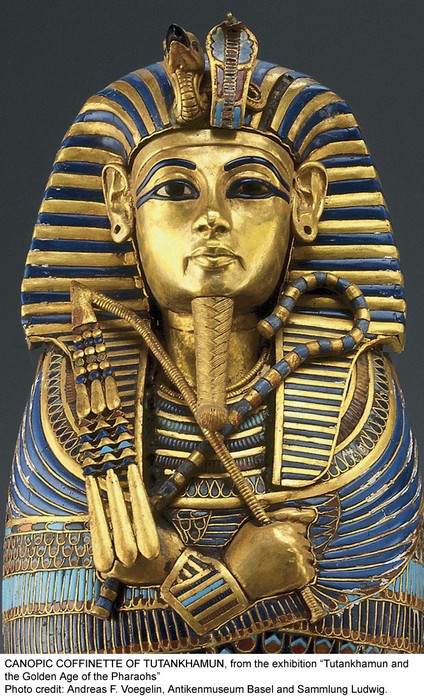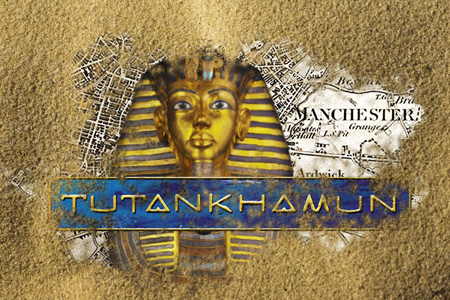From a variety of sources, we know of hundreds of sports and games in the ancient world, some of which one can be traced from the beginning of writing in about 3,000 BC to the time of the Middle Ages. Many of these pursuits played a prominent role in their respective societies and transcended mere sport to become associated, for example, with religion, entertainment, the military, and social customs. Several sports listed below have parallels in the modern world even though in some cases there may be no direct ancestry. I have extended the discussion to include (in one instance)…
-
-
Last week I visited the ‘Tutankhamun: His Tomb and His Treasures’ exhibition in Manchester with Mary-Ann Craig (video), and well… saw wonderful things, and everywhere, the glint of gold. The moment I marvelled at the recreation of the set-up used to remove Tutankhamun’s sarcophagi from his tomb, any doubts still left about the power of replicas disappeared, and I would strongly suggest you visit the touring exhibition before it leaves the UK. Yet, if you want an expert opinion the matter (as well as a great introduction to your visit), watch our Heritage Key video with Robert Partridge, editor of…
-
Researchers have discovered that 19 objects in New Yorks Metropolitan Museum of Art are from King Tuts tomb, and an agreement has been struck that will see them be returned to Egypt. The research indicates that Howard Carter kept a few pieces which were bequeathed to the Met after his death in 1939. The artefacts are quite small and at the time it was not known that they were from the tomb itself. Fifteen of the 19 pieces have the status of bits or samples, read a Supreme Council of Antiquities Press release. The remaining four are of more significant…
-
The royal tomb of Pharaoh Psusennes I is said to be one of the most spectacular discoveries ever made in Egypt. So, why hasn’t the world heard about it? And what does it reveal about Ancient Egypt? Find out in ‘Secrets of the Dead:The Silver Pharoah’, premiering this Wednesday. Tanis, Egypt, circa 1939. An excavation team led by French archaeologist Pierre Montet unearthed an intact royal burial chamber (NRT III), which containedtreasures that (almost) rivals the riches found in Tutankhamuns tomb almost two decades before. One of the most spectacular discoveries inside the crypt was the exquisite silver sarcophagus of…
-
Treasures from the tomb of King Tutankhamun will be seen in Australia for the first time, when the Melbourne Museum hosts ‘Tutankhamun and The Golden Age of The Pharaohs’, startingApril, 2011. Up to 700,000 people are expected to visit the exhibition, which will feature more than 130 artefacts from Tut’s tomb and the gravesand temples of his ancestors from Egypt’s 200-year ‘Golden Age’. Six months ago,Frank Howarth, director of Sydney’s Australian Museum, said the show’s $10 million price tag for six months, and its size were too big for Australian institutions to handle. In stead, the Australian Museum hosted the…
-
Acrobats from Burma, workers from Central or West Asia, and a mausoleum design inspired by work in the Middle East – the Mauseoleum of China’s First Emperor was a cosmopolitan place says Dr. Duan Qingbo, the man in charge of excavating it. The mausoleum was created about 2,200 year ago and served as a tomb for Qin Shi Huang – the first emperor of China. While the emperor’s tomb is largely unexcavated, archaeologists have found thousands of life-size terracotta figures nearby. It’s believed that this army was created to serve the emperor in the afterlife. Dr. Duan (Duan is his…
-
Acrobats from Burma, workers from Central or West Asia, and a mausoleum design inspired by work in the Middle East the Mauseoleum of Chinas First Emperor was a cosmopolitan place says Dr. Duan Qingbo, the man in charge of excavating it. The mausoleum was created about 2,200 year ago and served as a tomb for Qin Shi Huang the first emperor of China. While the emperors tomb is largely unexcavated, archaeologists have found thousands of life-size terracotta figures nearby. Its believed that this army was created to serve the emperor in the afterlife. Dr. Duan (Duan is his family name)…
-
King Tut’s treasures are returning to the UK, as ‘Tutankhamun His Tomb and His Treasures’ opened this weekend at Manchester’s Museum of Museums. Over 1,000 faithful replicas offer visitors the opportunity to look through Howard Carter’s eyes and experience the greatest discovery of all time for themselves. The entire world is familiar with ancient Egypt’s ‘piece de resistance’, the symbol of Egyptology King Tut’s golden death mask (slideshow). Yet, fewer people know that when Carter and Carnarvon discovered the pharaoh’s final resting place in 1922, it contained so many treasures that it was almost impossible to enter. It would take…
-
Almost 2,000 years after its last native speakers disappeared, the sound of Ancient Babylonian makes a comeback in an online audio archive. The recordings include excerpts from some of the earliest known works of world literature, dating back to the first years of the second millennium BC. Prompted by the enquiries of curious colleagues and friends, Dr. Martin Worthington, an expert in Babylonian and Assyrian grammar from the University of Cambridge, has begun to record readings of Babylonian poems, myths and other texts in the original tongue. In an effort to present users with a variety of voices, the readings…
-
Tickets go on sale today for “Secrets of the Silk Road” a landmark exhibition from China making its only East Coast stop at the University of Pennsylvania Museum of Archaeology and Anthropology (Penn Museum) in Philadelphia February 5 through June 5, 2011. The exhibition aims to reflect the wide extent of the Silk Road trade and cultural interchange (see some of the highlights in this slideshow). Despite of what its name suggests, the Silk Road isn’t one single route. Rather, it is an extensive interconnected network of maritime and overland trade routes extending from Southern Europe through The Arabian Peninsula,…





